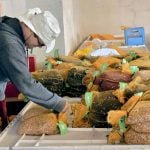Horses played a pivotal role in the history of this southern Alberta community, from the legendary rodeo bucking bronc Midnight to the mighty mounts of the North West Mounted Police that established an outpost here.
The local rodeo grounds are named for the horse bred by local cowboy Jimmy McNab. Midnight is buried at the Cowboys Hall of Fame in Oklahoma.
Less widely known is the town’s extensive trade in horse meat, with Bouvry’s Exports shipping to overseas customers.
The horses, men and wagon trains of the North West Mounted Police arrived here in 1874 to preserve Canadian sovereignty and protect local native bands from unscrupulous American whisky traders and wolf hunters.
Read Also

More factors affecting winter weather
When you combine a weak La Niña, early Siberian snow, and a warm northern Pacific, it’s easy to see why long-range winter forecasting is so complex.
The history of the town and a desire to raise Appaloosas drew Don Hunter here. He cited southern Alberta’s rich tradition in horses, riders, trainers and veterinarians.
“It’s a real interesting place to live because it was the frontier,” said Hunter, a hotel owner and member of the Fort Macleod and District Agricultural Society.
Hunter noted how former mayor Charlie Edgar served as a bugle boy for the NWMP riding out on patrol.
The town, named Macleod for a time, was once the largest settlement between Winnipeg and Vancouver when most prairie towns were little more than tent villages.
Incorporated in 1892, it hosted polo matches, balls and races in its early years.
Its historic Main Street is due to the fact the town was one of the first to take advantage of a provincial government program to retain its rich heritage.
It features a number of architecturally distinct buildings from the currently vacant American hotel to the Empress Theatre that still sports the circle in the wall from early projection equipment.
The town was a police outpost but also supplied the many settlers who came by wagon and later by train.
Long before the white settlers arrived, the natives had buffalo jumps and well established trading routes along the Oldman River, explained Gordon MacIvor, economic development officer for the town and administrator of the Fort Macleod provincial historic area society.
It was a local man, Jerry Potts, the son of a Scottish father and Blood Indian mother, who led the first contingent of NWMP and col. James
Macleod to the original townsite.
Short and bowlegged, the fearless Potts was known for settling scores with a gun or a knife in the typical fashion of a frontier town.
He was invaluable to the police as a scout who could grope his way through blinding snowstorms. Today, his remains lie in the RCMP’s field of honour graveyard in town.
Potts told Macleod the town site was a strategic site along the old north-south trading trail that crossed the Oldman River.
“He knew it was the best place for police to establish law and order,” said MacIvor.
From here, the NWMP would establish Fort Calgary and Fort Walsh.
Today, the town’s population numbers 3,000 and has changed little since the turn of the 20th century.
Local groups are working together to construct seven outpost buildings and establish an interpretive centre.
In its glory days, the fort managed two divisions and 43 detachments and was responsible for Medicine Hat, Calgary and Lethbridge. It housed prisoners and served as the site of at least one execution by hanging.
It served the NWMP until 1904, later becoming a training and recruitment centre for soldiers in the First World War, a provincial jail, a police detachment and militia headquarters.
Police were given farmland after serving with the force, which helped settle much of southern Alberta.














